 South Coast [ Shoalhaven ][ Clyde Coast ][ Eurobodalla ] Bhundoo |
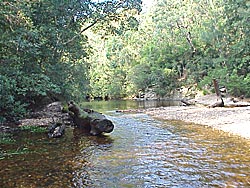
Rising in the rugged coastal mountain ranges, the river system flows south through these spectacular mountain regions, through three National Parks and no less than ten State Forests in the Clyde Valley, widening into a broad, navigable estuary and finally reaching the Pacific Ocean at Batemans Bay after a journey of around 125 kms. But this is no Mississippi, Nile or even River Murray. Indeed, during extremely dry periods, the Clyde is, in its upper reaches, reduced to merely a trickle. So, why is it so special? |
The Purity of its Waters
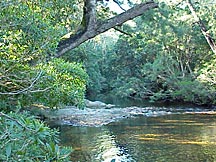
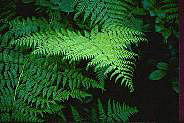 As a result, the Clyde has the cleanest, least polluted waters of any major river in Eastern Australia.
As a result, the Clyde has the cleanest, least polluted waters of any major river in Eastern Australia.The quality of this river is becoming widely recognised, with favourable support being received for the local application for listing on the National Estate of "The Waters of the Clyde" - such a listing recognising the need for this important natural asset to be protected for future generations.
Spectacular Mountain Sources
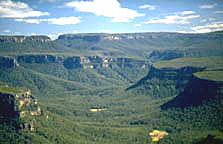
The quality of its water however, is only one part of the story of the Clyde. When locals talk about the Clyde, they are often referring to the upper catchment area of the river, shaped as it is by tectonic plate movement in the earth's crust to create the spectacular mountain and cliff terrain within which the Clyde rises. In its efforts to reach the sea, the river has sculptured a land of special qualities. The names of some of the features in the Upper Clyde are enough to convey the wonder and mystery of the place.
There are the landmarks of Pigeon House and The Castle standing as sentinels over Monolith Valley while the names of Shrouded Gods Mountain, Byangee Walls and the Ettrema Wilderness create their own special images.
This is the Clyde for the "true blue" ecotourist. Access to these wonders is by foot (after your vehicle reaches the end of the access roads) and may involve some steep and arduous treks, depending on which of the many trails that you take. But the rewards are rewards that only a trekker, bushwalker or lover of Australian nature in the raw, can appreciate : the feeling of achievement and of solitude, as well as the chance to experience landscapes of nature's splendour, almost untainted by human imprint.
The Clyde River Valley
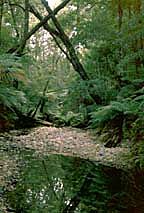
Bursting out of its mountainous source, the Clyde then meanders through the State Forests in the Clyde Valley, picking up volume from its many tributaries. In its middle stage, you can find picturesque reaches and pools where the forest meets the river; there are numerous swimming holes frequented by locals on hot summer days and by the platypus and the native bass throughout the year.
Grazing properties in this region are working towards a harmonious balance between their activities and their effect on the river and many people, conservationists and farmers, are actively engaged in preserving the unique values of the river system.
The river finally reaches Shallow Crossing, a ford across the river, near where the Clyde enters its estuarine and tidal state.
The Clyde Estuary
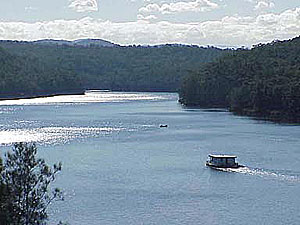 Finally, there is the importance of the estuary of the Clyde River to the Batemans Bay community.
Finally, there is the importance of the estuary of the Clyde River to the Batemans Bay community.The Clyde opens to its estuarine state more than 30kms from its mouth at Batemans Bay and from here it is navigable for larger craft. And indeed the history of the region and its development after British settlement was based on water transport on the Clyde estuary between the towns of Batemans Bay and Nelligen.
Today it is a focus for recreational use in these towns. Sailing, river and ocean fishing, pleasure cruises, sailboards and the outboard motor boat all find their place in the extensive waterways of the estuary.
Oyster farming in the estuary is also an important industry to the local community. This is the home of the "best oysters in the world" - a claim based on the quality of the waters in which they grow, as well as the breed of oysters grown here, namely Sydney Rock Oysters, widely considered by the connoisseur as the best of the best.
The estuary also provides the main focus for the town of Batemans Bay. The river reaching the sea by way of the Tollgate Islands provides a backdrop to the most attractive town on the NSW south coast. Many restaurants, motels and coffee shops have been sited to make the most of this beautiful estuary, which many consider makes the Bay remain in their memories.
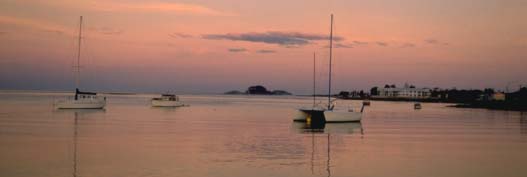
This is our river, the unifying feature for the communities of the Clyde Coast and a natural asset that is becoming increasingly rare in a developed world. This river drains a region that will provide a unique travel experience for the nature lover.
After you visit the Clyde and drink from its waters, next you need to visit our wonderful, unspoiled beaches .......... but that is another story.